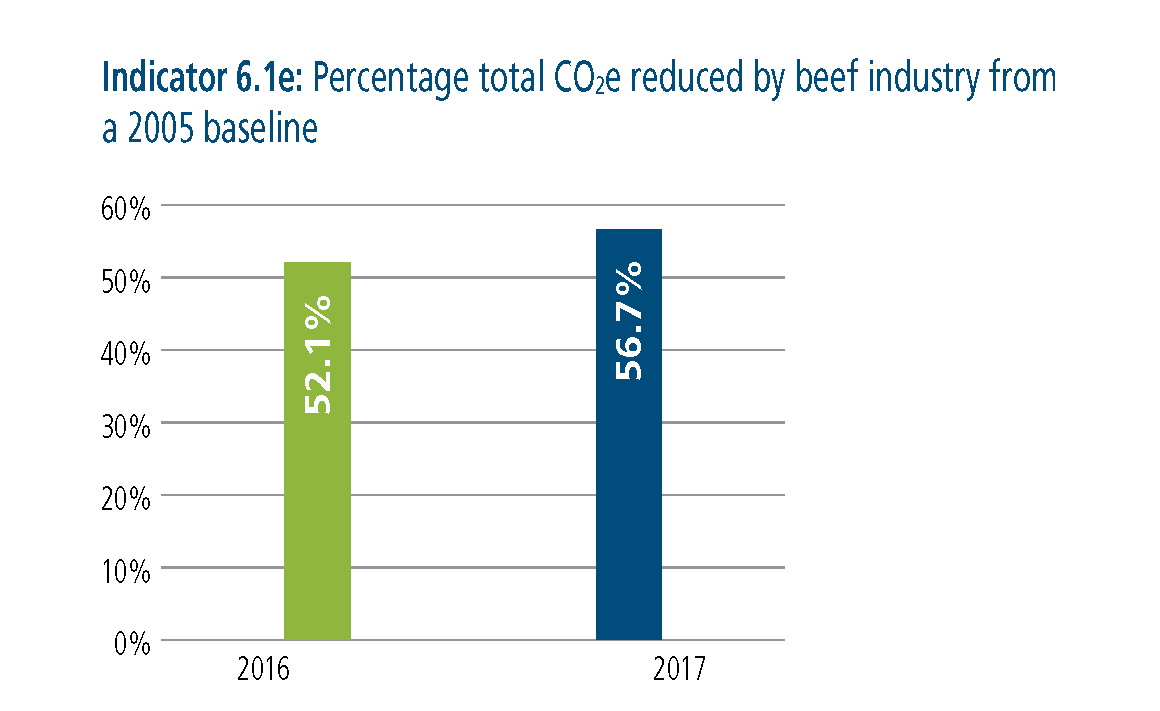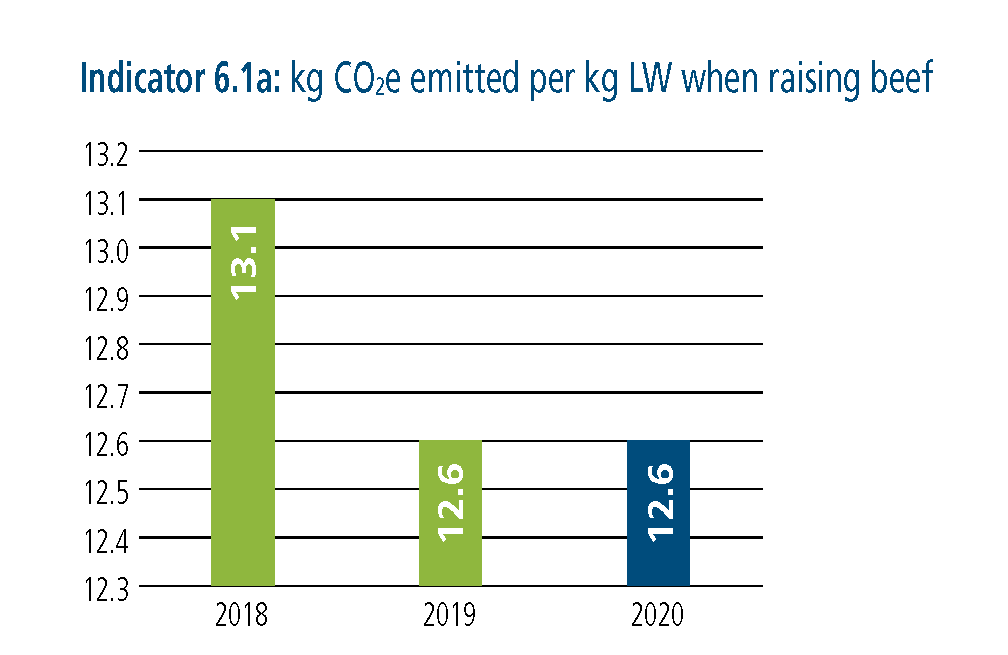Managing climate change risk
Climate is the biggest individual driver of production variability in agriculture. It is integral for the beef industry to adapt management practices to reflect our changing conditions, to ensure long-term industry prosperity.
In 2016, Australia (along with 175 other member states) committed to the global Paris Agreement to pursue efforts to keep global warming below 1.5°C above pre-industrial levels.
The beef industry plays an important role in offsetting national emissions by sequestering carbon in soils and vegetation.
Like all industries, Australia’s beef industry has a responsibility to focus on minimising emissions. The Australian beef and sheep industries currently contribute around 10% of Australia’s total greenhouse gas (GHG) emissions and over two thirds of this comes from cattle.
In addition to methane emitted by cattle, beef production also emits GHGs through:
- Meat processing.
- Loss of soil carbon in overgrazed pastures.
- Savannah burning conducted to manage woody weeds and promote pasture quality.
- Clearing of primary forests.
- Nitrous oxide from manure in feedlots.
- Application of nitrogen fertilisers to pastures and to grow grain.
- Upstream inputs such as chemicals and diesel.
Industry is currently investigating evolving ways of accounting livestock emissions such as GWP, which more accurately reflect the timeframe for decay of various GHGs in the atmosphere (CO2 has a longer life in the atmosphere than methane). At this stage, the Framework uses data from the National GHG Inventory which uses GWP100, though this may change based the ongoing work to update accounting methods.
Industry position
In 2017 the Australian red meat industry committed to achieving carbon neutrality by 2030 (CN30). The CN30 target definition is Net zero greenhouse gas emissions by 2030. This means that by 2030 the Australian beef, lamb and goat production, lot feeding, and processing value chain segments will make no net release of greenhouse gas (GHG) emissions into the atmosphere.
Red Meat 2030 outlines that CN30 will be achieved by:
- Identifying required actions and coordinating across the supply chain to achieve the target.
- Researching mechanisms and practices relating to pasture-based carbon sequestration, enteric methane emission reduction, and other mitigation technologies.
- Demonstrably reducing production, processing and consumption waste.
- Increasing research into, and use of, renewables within the industry’s energy mix.
CN30 is a clear message to global customers and consumers that the Australian red meat industry is serious about addressing GHG emissions. It will demonstrate that the red meat industry is a global leader in enteric methane and carbon farming innovation, economic development and environmental stewardship.
What is the data telling us?
The Framework publicly tracks the industry’s CN30 (Carbon Neutral by 2030) target. Since the baseline year of 2005, the industry has reduced net emissions by 56.7% largely through a focus on improving productivity and vegetation management practices.

This figure was calculated by CSIRO from datasets contained in the Australian National Inventory Report across the agriculture and land use categories, relating to beef production.
The figure from last year’s report has been restated from 55.7 to 52.1%. The Department of Industry, Science, Energy and Resources review and update activity data and the inventory methodology each year, and changes are applied retrospectively to past inventories. The 2016 figure has been restated applying these retrospective changes.
This reduction is reflected in a decrease in emissions intensity, as measured through a Life Cycle Assessment. MLA conducts an LCA every five years and the most recent LCA, completed in 2019, showed a 3.8% reduction in emissions intensity across the industry from 13.1 to 12.6 kg CO2e per kg liveweight when raising beef from farm to processor.

Measuring carbon sequestration is a relatively new technology, and trials are currently underway to verify scientifically sound methods which will allow the industry to verify the amount of carbon stored through farming practices.
A snapshot of activity
CN30 is an aspirational target for the Australian red meat industry to be carbon neutral by 2030. Research, adoption and commercialisation for the red meat industry is led by MLA.
The 2030 target was set following industry-funded research undertaken by CSIRO in 2017. This research showed that, with industry commitment, the right policy settings, and investment in research, development and adoption, the Australian red meat industry can be carbon neutral by 2030.
CN30 aims to unlock $300m per year for the Australian red meat industry by optimising the carbon cycle to improve drought resilience and farmgate profitability and reduce GHG emissions.
Industry is investing in areas such as animal genetics and husbandry procedures, reducing methane emissions from livestock, viable grazing supplement delivery technologies, soil carbon sequestration methods, and integration of trees and shrubs for improved carbon storage.
CN30 activities are grouped into four key work areas.
Emissions avoidance
Enteric methane production in the rumen equates to lost productivity (50-90 kg methane/year is equivalent to 33-60 grazing days lost per year). The emissions avoidance work area includes projects that aim to increase productivity by redirecting more energy from pastures into liveweight gain rather than to enteric methane production.
Research being conducted that may lead to these outcomes includes investigating novel legumes for northern and southern environments, investigating marine and terrestrial plants for methane inhibiting properties, furthering research on additives and supplements that may decrease enteric methane by up to 80% while increasing animal weight gain (such as red asparagopsis algae and 3-NOP), identifying additional compounds and supplements that may reduce enteric methane, and identifying appropriate commercialisation and delivery mechanisms for these additives to facilitate widespread adoption. A separate project in northern Australia aims to mobilise landholders to earn income from savannah fire management through supporting Emissions Reduction Fund (ERF) methods for sequestering carbon.
Carbon storage
Methane produced from livestock production can be offset by storage of carbon in above and below ground biomass. Some Australian beef producers have already achieved carbon neutral or low carbon systems through practices that allow them to store the same or more CO2 than is emitted from their operation through enteric methane. H2O A2
Research being conducted to support farmers to adopt practices that may offset some or all of their emissions includes technology for measuring soil carbon, identifying co-benefits of planting trees in optimal locations within properties, and identifying pasture species that will promote increased soil carbon stocks. A five-year project led by MLA in conjunction with funding and research partners is also investigating the enduring benefits of dung beetle ecosystem engineers in reducing nutrient run-off into waterways and improving soil systems and soil carbon storage.
Integrated management
The integrated management work area aims to create packages of recommended practices from the emissions avoidance and carbon storage work areas, supported with underlying frameworks, software, business cases and models to support their adoption. This work area also includes working with industry stakeholders to ensure carbon accounting measurements and methods for generating carbon credits are scientifically robust.
This work area also includes the Managing Climate Variability Program (MCV), which is the lead research and development program in Australia for providing climate knowledge to primary producers. Current priorities of the program include incorporating seasonal climate information into individual decision-making, improving forecasting of extreme climate events, and helping producers understand what drives seasonal rainfall in their region. Future MLA projects are exploring profitability and resilience through adapting to future climates. Economic modelling suggests that the potential payoff from climate adaptation could be close to $1.1 billion.
Leadership building
The leadership building work area includes activities that aim to build leadership capacity and competency across industry to enable the transition to a carbon neutral position in 2030.
As part of this work area, MLA is working with producers to build capability around carbon accounting and identifying practices to balance net emissions with stored carbon.
MLA is also nurturing existing relationships, and developing new ones, to identify industry leaders. They are also aligning relevant industry strategies and frameworks, such as Red Meat 2030, and working with government to set clear and stable evidence-based policy that supports research, development and adoption.